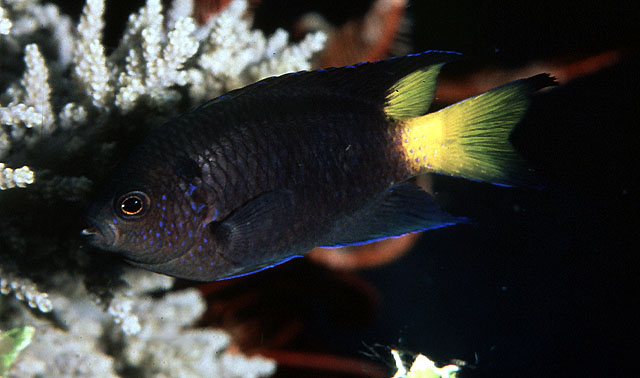| Pomacentridae (Damselfishes), subfamily: Pomacentrinae |
| 7.5 cm TL (male/unsexed) |
|
reef-associated; marine; depth range 1 - 30 m, non-migratory |
| Western Central Pacific: Indonesia to Solomon Islands, north to Japan, south to northern Australia and Vanuatu. |
|
Dorsal spines (total): 13-13; Dorsal soft rays (total): 11-12; Anal spines: 2-2; Anal soft rays: 10-11. Description: Overall purplish brown (Ref. 90102), more black than violet (Ref. 37816), ear spot and pectoral fin base spot black, caudal fin and posterior of dorsal and anal fins yellow. Body depth 2.4-2.6 in SL (Ref. 90102) |
| Adults are found in lagoons, harbors, and coastal reefs, shallow habitats, deep sand or mud slopes with outcrops of debris or coral rubble pieces, or on rocky substrates in sheltered bays. They usually occur in large aggregations, sometimes forming mixed aggregations with Neopomacentrus sp. Abundant around sponge-encrusted mooring buoys and their anchor lines and occur in smaller colonies around rocks and refuse (Ref. 1602). Oviparous, distinct pairing during breeding (Ref. 205). Eggs are demersal and adhere to the substrate (Ref. 205). Males guard and aerate the eggs (Ref. 205). Diurnal species (Ref. 113699). |
|
Least Concern (LC); Date assessed: 23 September 2021 Ref. (130435)
|
| harmless |
Source and more info: www.fishbase.org. For personal, classroom, and other internal use only. Not for publication.

